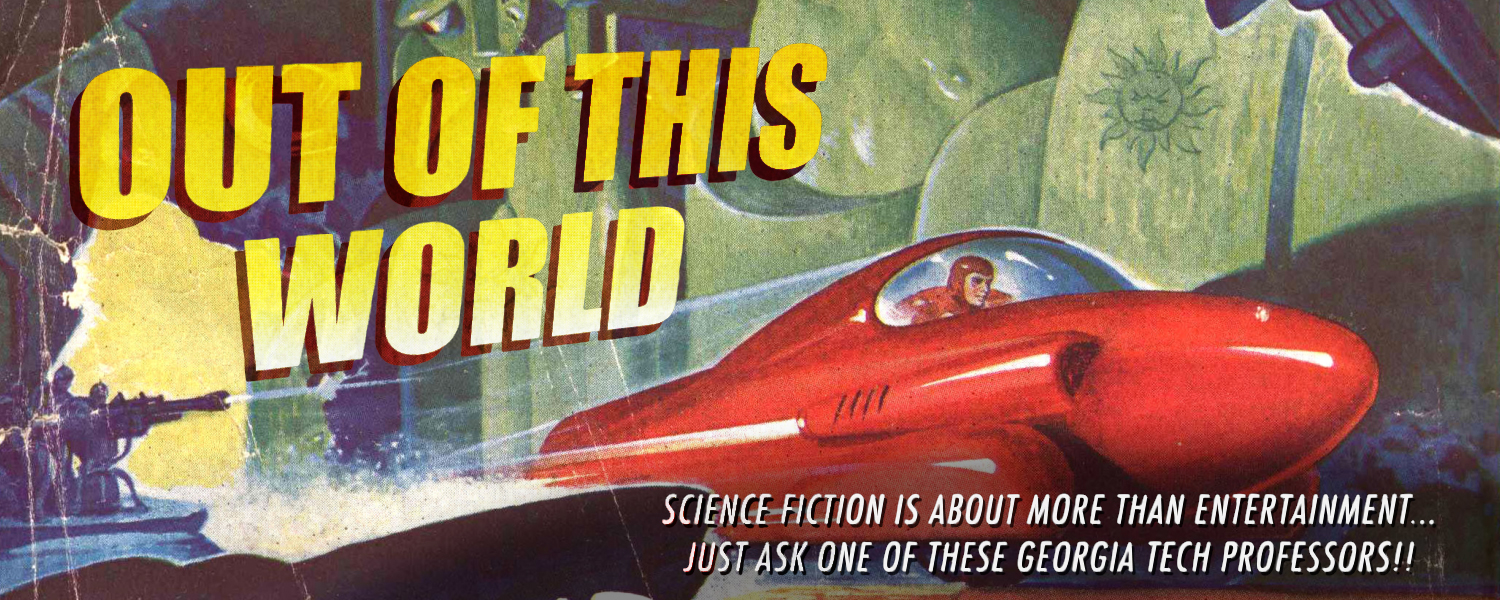
Out of This World
By Stacy Braukman and Jason Maderer | Published August 28, 2018
From Black Mirror to Black Panther. From the machines of Westworld to the red planet in The Martian. From the return of Star Wars to the reboot of Lost in Space.

The past decade has witnessed a flurry of successful science fiction books, television shows, and movies. It’s the latest crest in a series of ebbs and flows that have characterized the genre since the turn of the last century.

Professor Lisa Yaszek
“The past 120 years have been defined by rapid change, and science fiction can help us make sense of that change,” says Lisa Yaszek, a professor in the School of Literature, Media, and Communication who has studied science fiction for nearly 20 years. “The genre challenges us to contemplate what our world might look like when a change becomes the new norm.”
Yaszek is one of three sci-fi faculty experts in Georgia Tech’s Ivan Allen College of Liberal Arts, and you can often find her in the Skiles Building Sci Fi Lab with Professor Jay Telotte and Associate Professor Susana Morris.
Together, the trio can map the history of science fiction. And they will tell you that the genre’s enormous popularity of late is being driven, as it always has — for better or worse — by real-world events.

Bicentennial of a Birth
Some scholars argue that science fiction originated at the dawn of fiction itself. They point to the Epic of Gilgamesh, a Mesopotamian text that was crafted around 2,000 B.C. The poem explores human immortality, although it lacks specific references to anything that would have been construed as science or technology at the time.

Mary Shelley, author of Frankenstein
Others look to 1818, exactly 200 years ago. That’s when Mary Shelley wrote a novel about a young scientific genius who creates artificial life but who, through a combination of bad science and bad parenting, transforms that new life into something as monstrous as the scientist himself. In Frankenstein, Shelley created an enduring science fiction story, which has been retold thousands of times in nearly every form of media. For Yaszek and many others, it’s where the genre truly began.

Boris Karloff as Frankenstein's monster in The Bride of Frankenstein (1935).
“Shelley extrapolated from the most exciting, cutting-edge sciences of her time — galvanism, new theories of evolution, sexual reproduction, and education,” Yaszek says. “She imagined what a new kind of humanity or ‘posthumanity’ might look like, and produced one of the most exciting themes in contemporary science fiction.”

New Ways of Telling New Stories
The early 20th century saw emerging technologies that allowed science fiction
enthusiasts to tell their tales in new ways. Authors had dreamed of visiting the moon for
centuries, but in 1902 director Georges Méliès did it with film.
A Trip to the Moon was one of the most widely viewed early science fiction movies,
producing an iconic scene you may recognize even if you’ve never heard of the movie — a rocket
plunging into the eye of a moon face.

A Trip to the Moon (1902)
“A Trip to the Moon was partly done for laughs, but it was very influential,” says Telotte, who is in his 38th year of teaching film history at Tech.

Amazing Stories, June 1947, Volume 21, Number 6
Metropolis, a groundbreaking 1927 film that brought a humanoid robot to the big screen for the first time, was also noteworthy for casting a woman as the leader of a workers’ revolt — part of a larger shift in cultural representations of women in the 1920s that discarded Victorian ideals in favor of modernism. The film functioned as social critique as well, addressing issues like industrialization and mechanization, labor organizing, and fears of global conflict.
The decade also introduced American audiences to pulp magazines. The first and most popular was Amazing Stories, launched in 1926. Publisher Hugo Gernsback’s magazine was devoted to stories about the future of science and technology. He even gave the style a name: “scientifiction.” One fan later used the shorter and easier term "science fiction," and it stuck.

Science Fiction Enters the Twilight Zone

Klaatu and Gort from The Day the Earth Stood Still (1951)
In the 1950s, science fiction films reflected real-world anxieties, from the cold war and space exploration to domestic subversion. Six years after Hiroshima, two films — The Day the Earth Stood Still and The Thing from Another World — explored the potential horrors of atomic energy. Until that point, science fiction had been largely a mainstay in magazines, radio, and film. By the end of the 1950s, though, Rod Serling was revolutionizing the genre on the small screen with The Twilight Zone.
“That show radically changed how people saw science fiction,” says Telotte. “Space operas had dominated until that point with their cheap, $25-per-week special effects budgets. Serling had a bigger budget, could film on the one of the largest back lots in the world, and had every prop imaginable because of MGM Studios.”

Lea Waggner and Barry Atwater in The Twilight Zone episode, "The Monsters Are Due on Maple Street," which aired on CBS on March 4, 1960.
These resources, according to Telotte, allowed Serling to pursue new avenues of storytelling.
For example, in one of the show’s best-known episodes, “The Monsters Are Due on Maple Street,” a
flying saucer whizzed across the TV screen in a cinematic style of science fiction that no one
had witnessed from their living room before.
“It cost Serling almost nothing,” says Telotte. “The saucer was borrowed from MGM’s Forbidden
Planet (1956), the most expensive science fiction film of its time. And while TV was
fairly conservative in the 1950s, Serling showed that if you packaged it correctly, you could
say all sorts of things to audiences that might otherwise not reach the screen.”
The Twilight Zone aired until 1964. Its success paved the way for shows like Outer Limits, Doctor Who, and most notably Star Trek in 1966, which brought a new and vital element to the genre: diversity. (The show also spawned an ardent subculture of fan conventions that have steadily grown in size and scope over the past four decades.)

Anyone Can Be a (S)hero

Nichele Nichols as Star Trek's Lieutenant Uhura
Nichele Nichols played Lieutenant Nyota Uhura, who served as the chief communications officer on the starship Enterprise.
While it was a pioneering role for African-Americans in television, it wasn’t Nichols’s dream job. She wanted to be on Broadway and had planned to quit Star Trek after the first season. It wasn't until her self-described biggest fan, an Atlanta preacher, implored her to stay and called her an inspiration that Nichols agreed to return. As it happens, that fan was Martin Luther King Jr.
“Star Trek demonstrated that anyone could be an outer space bureaucrat,” says Morris, who teaches Afrofuturism in the Ivan Allen College of Liberal Arts. “A black woman; an Asian man. Everyone is capable of solving problems and getting a good job, even if it’s intergalactic.”
In 1977, another female character broke new ground in science fiction in a film series that continues to thrill audiences more than 40 years later.
“Princess Leia was the first science fiction princess to save herself. The first sci-fi ‘shero,’” says Yaszek. “The guys came to save her. She said thanks, explained why their rescue plan wouldn’t work, then picked up a gun and fought her way out of danger with them. She inspired me and an entire generation.”
Star Wars brought science fiction to the masses in a way that revolutionized the genre — and movies themselves. Earlier films, such as Stanley Kubrick’s 2001: A Space Odyssey (1966), had attracted audiences and critical acclaim, but Star Wars was a bona fide blockbuster with dazzling production values and sophisticated special effects.
“The success of Star Wars made money available to producers and studios interested in our genre,” says Telotte. Among many other things, it opened up the sci-fi floodgates.

Life Since Star Wars

© Lucasfilm Ltd. & TM. All Rights Reserved
Science fiction has never looked back.
Space travel, time travel, visitors from other planets, imagined worlds, the reappearance of dinosaurs! All were backdrops for some of the highest-grossing films and franchises in history: Alien, E.T., The Terminator, Jurassic Park, and The Matrix, followed by Avatar and now a seemingly endless stream of superhero movies. And that’s just on the big screen. Television brought us The X-Files, Lost, and Battlestar Galactica (both in the 1970s and a 2004 reboot). There are sci-fi video games, computer games, and apps galore. Science fiction novels continue to be wildly popular. In 1992, the genre even scored its own cable television network, the Sci-Fi Channel, which rebranded itself — to the initial dismay of fans and English majors alike — as “Syfy” in 2009.
Which brings us to the current era, dominated by zombies and Stranger Things.
The Georgia Tech trio says there are many explanations for the recent sci-fi boom. For Yaszek, it’s partly about politics.
“The U.S. elected the first African-American president in 2008, which was certainly a big change for our country,” she said. “Then we experienced a great shift in the other direction in the 2016 election. It’s not a surprise that we’re seeing more content that challenges us to think about change becoming the norm.”
Yaszek also talks about why we need science fiction, both individually and as a culture — aside from its value as escapist entertainment and sheer fun. It can, she says, enable us to question the status quo in a non-threatening way, and to articulate and explore issues we are already thinking about. Some of it serves to warn about dark or terrifying futures, but it can also inspire us to imagine brighter ones.
Perhaps most intriguingly, science fiction can inspire actual advances in science and technology, whether it’s Jules Verne’s fictional electric submersibles and lunar modules or Star Trek’s communicators (progenitor of the flip phone), or H.G. Wells writing about something called an “atomic bomb” three decades before one was actually built.
Morris doesn’t see the genre’s relevance or popularity waning any time soon.

SpaceX is at the forefront of commercializing space. Photo credit: SpaceX
“Commercial space companies are preparing to launch people into space for the first time. Next will be humans, and maybe colonies, on Mars,” she says. “Those topics will provide even more fodder for authors and producers.”
Morris also predicts more content featuring African-American characters, following the box office successes of Black Panther and Get Out.
No matter the source of inspiration, Telotte believes that science fiction will always exist because, whether we’re aware of it or not, it plays a significant role in our lives.
“We trip over science fiction every day,” he says. “If we talk about reality, we pretty much talk about science and technology. They challenge, change, and bother us. That’s what science fiction does. It bothers us in our complacency about the changes happening all around us. I hope that’s what it will continue to do.”
Learn how you can minor in science fiction studies!
Work with exceptional faculty, and do a deep dive into science fiction as an academic discipline.


